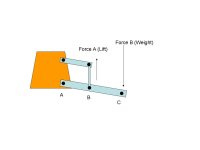design
Silver Member
I have a M5400 and I just moved 1700#'s of shingles on a pallet using the loader with a bradco fork attachment. With a well balasted tractor, that much weight 24" in front of the loader pins makes the tractor very light in the rear end. Going backward up my driveway was enough that I needed to engage 4WD to avoid slipping the rear tires.
1 degree driveway, Loaded 16.9x28 rears and a 600# counter weight. (Tractor weight about 7500#(tractor, loader frame, Counter weight, and loaded tires)
At 2500# for bucket capacity, look to the larger M series Ag tractors or the M59.
Design
1 degree driveway, Loaded 16.9x28 rears and a 600# counter weight. (Tractor weight about 7500#(tractor, loader frame, Counter weight, and loaded tires)
At 2500# for bucket capacity, look to the larger M series Ag tractors or the M59.
Design
